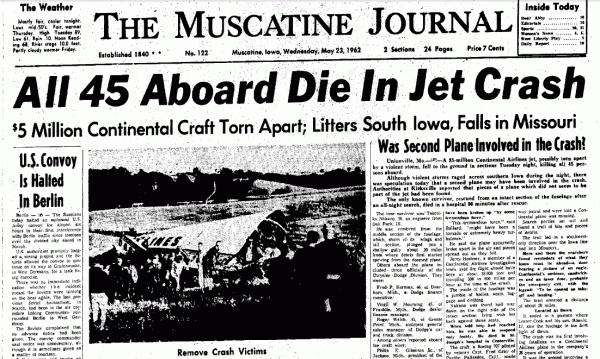The May 22, 1962 Continental Airlines Crash
Weather often is a contributing factor in plane crashes. But investigation sometimes reveals something beyond the obvious.
News stories on Wednesday, May 23, 1962 included word that a U.S. convoy in Berlin had been stopped by the Russians as tensions heightened between the super powers in Europe. Smoke from forest fires in the Everglades threatened the launch of the Project Mercury rocket that was scheduled to take astronaut Scott Carpenter into a triple earth orbit.
But the main headline was about a plane crash in the Midwest. The evening before, Jack Morris and Leo Craver had been traveling along highway 60, about five miles south of Centerville, Iowa. They came across a curved piece of metal lying in the highway. They took it to the Centerville police station. A call to the state patrol revealed that a Continental Airlines plane had disappeared from radar in the area. Searchers started following a trail of debris that had fallen from the sky along a twenty-mile path from southern Iowa into Missouri.
The trail led to a pile of wreckage of the Boeing 707 in a field near Unionville, Missouri. Only one survivor was found out of the 45 people on board, but he died a short time later. The plane had left Chicago at 9:25 p.m. and was due in Kansas City an hour and ten minutes later. Initial reports indicated that the plane might have been torn apart by violent storms that had been raging across the area during the evening. Winds had leveled trees, power lines and small buildings and blew out windows across the state of Iowa.
But the weather had nothing to do with the crash.
Investigators would find out that one of the passengers, Thomas Doty, a 34 year old man from Kansas City had taken out more than $300,000 in life insurance prior to the flight. He was facing charges of armed robbery and carrying a concealed weapon. Rather than face those charges, he decided to commit suicide by bringing down the plane. He did it with dynamite placed in the aircraft’s lavatory.
So, that’s a case of weather being incorrectly blamed in an aircraft disaster, from the pages of this week in weather history.
Follow my weather history tweets on Twitter. I am wxhistorian on Twitter.com.
Category: Met 101/Weather History
















